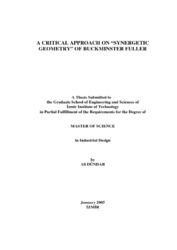Please use this identifier to cite or link to this item:
https://hdl.handle.net/11147/3275Full metadata record
| DC Field | Value | Language |
|---|---|---|
| dc.contributor.advisor | Erkarslan, Önder | en |
| dc.contributor.author | Dündar, Ali | - |
| dc.date.accessioned | 2014-07-22T13:51:13Z | - |
| dc.date.available | 2014-07-22T13:51:13Z | - |
| dc.date.issued | 2005 | en |
| dc.identifier.uri | http://hdl.handle.net/11147/3275 | - |
| dc.description | Thesis (Master)--Izmir Institute of Technology, Industrial Design, Izmir, 2005 | en |
| dc.description | Includes bibliographical references (leaves: 77) | en |
| dc.description | Text in English; Abstract: Turkish and English | en |
| dc.description | ix, 91 leaves | en |
| dc.description.abstract | Synergetic Geometry is a new geometry apprehension that R. Buckminster Fuller constituted its theoretical and practical underpinnings. In fact, Synergetic Geometry was a consequence of an experienced process that was developed by Fuller in his four design products and finally, materialized in Geodesic Dome. This study will focus on Synergetic Geometry of Fuller, and its reflections and its development levels on his products.Fuller criticizes industrial design as being non-industrialized practice, and criticizes industrial designers as being pure interior and exterior decorators. On the contrary, Fuller describes industrial design as interdisciplinary profession. Thus, industrial design cannot be undertaken as decoration and ornament. It is a whole system that includes different constituents and sciences, and it has to be handled as a design science and industrialized practice, rather than non-industrialized practice. Seen from this vantage point, Fuller innovated to the profession of industrial design by his products and his design conceptions.The aims of this study are the analysis of the four experiences which were the milestones of the .Synergetic Geometry. that is the destination of the thought derived from a geometrical analogy; and, the process of materialisation of the Synergetic Geometry that is elaborated in the context of the conceptual tools of Fuller (complementarity, system and synergy, and tensegrity) which constituted the Synergetic Geometry thought. Despite the fact that the four experiences of Fuller (Dymaxion Bathroom, Dymaxion Car, Dymaxion Deployment Unit, Wichita House) were marketable.easily convertible to cash.and proper to mass-production; they remained avant-garde in terms of becoming threshold products for further developments. For that reason, this study will also concentrate on his four experiences from the point of view that their crucial roles in design history have to be emphasized. | en |
| dc.language.iso | en | en_US |
| dc.publisher | Izmir Institute of Technology | en |
| dc.rights | info:eu-repo/semantics/openAccess | en_US |
| dc.subject | Synergetic geometry | en |
| dc.subject | Complementarity | en |
| dc.subject.lcc | TA140.F9 .D62 2005 | en |
| dc.subject.lcsh | Fuller, R. Buckminster (Richard Buckminster), 1895- | en |
| dc.subject.lcsh | Design, Industrial | en |
| dc.title | A critical approach on "synergetic geometry" of Buckminster Fuller | en_US |
| dc.type | Master Thesis | en_US |
| dc.institutionauthor | Dündar, Ali | - |
| dc.department | Thesis (Master)--İzmir Institute of Technology, Industrial Design | en_US |
| dc.relation.publicationcategory | Tez | en_US |
| item.fulltext | With Fulltext | - |
| item.grantfulltext | open | - |
| item.languageiso639-1 | en | - |
| item.openairecristype | http://purl.org/coar/resource_type/c_18cf | - |
| item.cerifentitytype | Publications | - |
| item.openairetype | Master Thesis | - |
| Appears in Collections: | Master Degree / Yüksek Lisans Tezleri | |
Files in This Item:
| File | Description | Size | Format | |
|---|---|---|---|---|
| T000431.pdf | MasterThesis | 131.28 MB | Adobe PDF |  View/Open |
CORE Recommender
Page view(s)
182
checked on Nov 18, 2024
Download(s)
154
checked on Nov 18, 2024
Google ScholarTM
Check
Items in GCRIS Repository are protected by copyright, with all rights reserved, unless otherwise indicated.